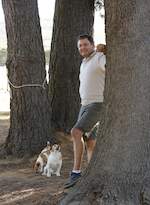The trio of super-premiums had been a little longer in coming than expected. This was due to a combination of the Mackenzies' caution and some travail in the cellar as well as in the vineyards.

'I'd wanted to make a premium red blend from the moment I arrived,' says Carl Schultz. 'I'd just come from Simonsig where we'd been working on their Tiara. I was young and enthusiastic and I thought some experimental wines I'd made from Hartenberg's newly planted vineyards on their carefully chosen sites showed huge potential. But the Mackenzies, to their credit, never do things in a hurry. If it was going to be premium, it had to be very, very good.'
Carl’s searching mind, thirst for knowledge, and quiet, the unassuming intellect has seen him travel widely on study tours, from the Rhinegau to Alsace, Burgundy to the Rhône, through the cork forests and industry of Portugal to Australia (for an international Shiraz producers' conference) and further south to New Zealand.
It was on a trip to Tuscany with Johan Malan in 1994 that he met Alberto Antonini. 'He’s an absolute character: he used to play Led Zeppelin at full pitch in the cellars to the distraction of his colleagues.' When the Mackenzies eventually succumbed in 2001 to Carl’s 'dripping tap technique' to start working on a super-premium red blend, he contacted the Italian. Antonini was now consulting internationally, having left Antinori after helping develop their super Tuscan Tignanello.
What started as 'some advice on cellar techniques' turned into a full-fledged consultancy, beginning in the vineyards. 'It’s the way he works: incredibly thorough.' It’s Carl’s way too. One nerve-wracking decision in 2004 gradually was to gradually grub up some of the top-performing Gravel Hill shiraz vines, increasingly infected by the contagious leafroll virus, and to replant the vineyard with a new Côte-Rôtie clone. New shiraz vineyards were also established on higher, poorer soils, leaving lower-lying, moisture-retaining soils to other better-suited varieties. And a broader understanding of vines came through experimental devices, such as a metal sleeve attached to the stem of sensitive merlot to monitor flexion and indicate the degree of stress due to lack of water.
Of course, these radical though well-researched moves found immediate resonance with a vintner fascinated by the vine. And it’s all paid off. In 2011, among all the accolades, perhaps the most satisfying was the 90+ scores awarded to seven of Carl's current vintages in American wine critic Robert Parker's influential The Wine Advocate. So too the international first place for the Stork 2008 at the Syrah du Monde in 2012.
Given his particular penchant for shiraz and riesling, he's more inclined to talk about two new seasonal festivals he hosts at Hartenberg: Riesling Rocks (summer) and Shiraz & Charcuterie (winter). The aim is not only to foster an appreciation of the two wine types among discerning wine lovers and connoisseurs but to inspire and be inspired by fellow winemakers working with the same varieties.
 Crayfish risotto with cauliflower purée and lime and vanilla dressing recipe by Carl Schultz paired with The Eleanor Chardonnay wine....
Crayfish risotto with cauliflower purée and lime and vanilla dressing recipe by Carl Schultz paired with The Eleanor Chardonnay wine.... Springbok or beef fillet with red wine jus recipe by Carl Schultz. Paired with The Stork Shiraz, Gravel Hill Shiraz or Hartenberg Estate Shi...
Springbok or beef fillet with red wine jus recipe by Carl Schultz. Paired with The Stork Shiraz, Gravel Hill Shiraz or Hartenberg Estate Shi...